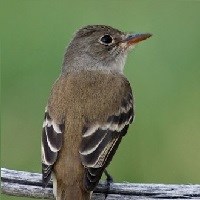
Rich Hansen, Utah Division of Wildlife Resources
The Colorado River runs for 277 miles through Grand Canyon National Park. Combined with miles of springs and tributary streams, the Grand Canyon is home to a massive network of riparian areas that are key habitat for hundreds of species. These aquatic areas are water holes in an arid environment, provide abundant food sources, and are filled with thick vegetation which is ideal habitat for many birds species. Many species, such as belted kingfishers, live in the Canyon year round, feeding on native fish in the Colorado River and its tributaries. Migratory birds, like the lesser scaup, rely on the Canyon as important winter habitat when their summer ranges become too cold. And for yet other species, like the critically endangered southwestern willow flycatcher, the waterways in the Grand Canyon are important nesting habitat.

NPS Robb Hannawacker North America's only aquatic songbird, the American dipper is a rarely-seen bird that lives in the Grand Canyon year-round. 
US Fish and Wildlife Service With their prominent crest, large beak, and fishing behavior, kingfishers are an iconic riparian species. They are often seen perched on branches overlooking the Colorado River, waiting for fish to pass below. 
US Fish and Wildlife Service One of the migratory species that rely on the Grand Canyon for habitat, lesser scaups are a species of diving duck that spend the winter along the Colorado River before returning to their summer habitat in Canada and the northern United State.

Natural Resources Conservation Service- Colorado, USDA Southwestern Willow Flycatcher A critically endangered species, these flycatchers build their nests in the thick vegetation along the Colorado River- one of the only places in the world where they continue to breed in the wild. |
Last updated: April 17, 2019
